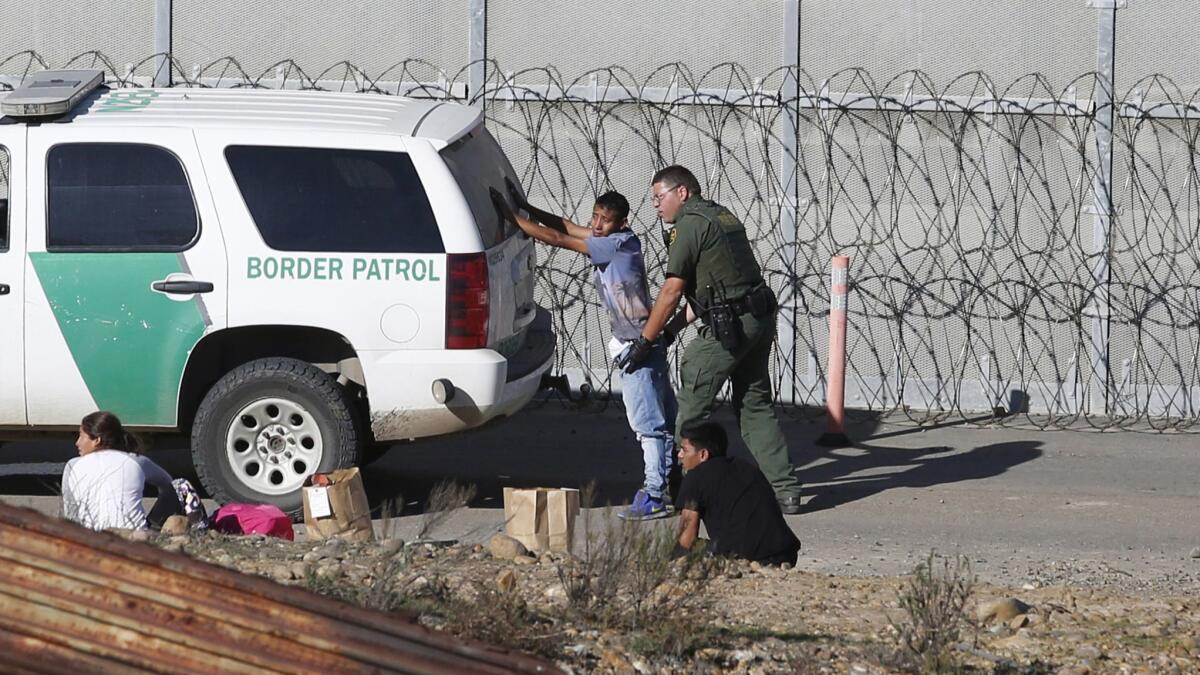Opinion: Every aspect of America’s asylum system now seems broken

- Share via
The Trump administration has attempted to close the door on asylum seekers who are looking for refuge in the United States. But even as it blocks entry — and sends tens of thousands of asylum seekers to Mexico to wait out their immigration proceedings — thousands of families with children are also being held in federal immigration detention facilities.
Because the administration has prohibited advocacy groups, journalists, immigration attorneys and even congressional staff from entering detention facilities to document conditions and interview detainees, the public has had only anecdotal glimpses into how detainees were treated. Now we have systematic evidence to support accounts of the harsh conditions that asylum seekers experience in immigration detention. In many ways, it is worse than we thought.
From October 2018 through June 2019, the San Diego Rapid Response Network (SDRRN) assisted approximately 7,300 asylum-seeking families at their shelters. These families, who were processed and then admitted into the U.S., totaled more than 17,000 people, including 7,900 children 5 years old or younger. My team and I at the U.S. Immigration Policy Center (USIPC) at UC San Diego independently analyzed intake data collected by the SDRRN for all of these families.
In a report released last week, we found that approximately 35% of the asylum-seeking heads of households we studied reported problems related to conditions in immigration detention, treatment in immigration detention, or medical issues. This finding is alarming since it’s very likely an underestimate, because the SDRRN was focused on providing needed services to the asylum-seeking families, not administering questionnaires. Moreover, abuses or problems in detention may be underreported by asylum seekers who are afraid that raising complaints may negatively affect their asylum case.
Of those who reported issues related to conditions in detention, approximately 6 out of 10 reported food and water problems, including not having enough to eat, being fed frozen food, being fed spoiled food, not being given formula for infants, not being given water, and having to drink dirty or foul-tasting water. Approximately half reported having to sleep on the floor, having to sleep with the lights on, overcrowded conditions, confinement, and the temperature being too cold in “la hielera,” the detention facilities known as the “iceboxes.” Approximately 1 out of every 3 reported not having access to clean or sanitary toilets, being able to shower or being able to brush their teeth.
About 1 out of 10 of the asylum-seeking heads of households — or more than 700 of them — reported verbal abuse, physical abuse or some form of mistreatment in immigration detention. Examples of verbal abuse include being told “we don’t want your kind here” and “you’re an ape,” among others. Examples of physical abuse include being thrown against the wall when attempting to get a drink of water.
The data also showed the great diversity of those who arrive at the southern border to seek refuge. The majority of the asylum-seeking families came from the “Northern Triangle” of Central America — Honduras, Guatemala and El Salvador. However, many also came from other continents, 28 in all, including the Democratic Republic of Congo, Russia, Kazakhstan, India, China and Vietnam, to name a few. Any changes to U.S. asylum policies meant to deter Central Americans from entering at the southern border will affect asylum seekers from all over the world who are also looking to the U.S. for safety.
We also found that just over 1 out of 5 of these families do not speak Spanish as their primary language. The languages spoken range from indigenous Central American languages — including K’iche’, Q’eqchi’ and Mam — to Creole, Mandarin, Portuguese, Russian, Hindi, Vietnamese and Romanian, among others. This linguistic diversity presents another set of challenges.
When asylum seekers are released from detention, they are given detailed instructions on a form called the “Notice to Appear,” including instructions about their immigration court dates, times and locations. On the notice, immigration officials indicate the language that the asylum seeker was given these instructions in. For those whose primary language is not Spanish, nearly 9 out of every 10 were nevertheless given instructions in Spanish. If these families are not provided instructions about their immigration proceedings in a language they can understand, they will not be able to navigate an extremely complex legal process, which may infringe on their basic rights to due process.
From substandard conditions in immigration detention to verbal and physical abuse to serious due process concerns, the data show that the Trump administration is not abiding by its obligations under U.S. and international asylum and refugee law to treat humanely those who are seeking protection from persecution.
With the administration now determined to hold asylum-seeking families for potentially as long as it takes for their immigration proceedings to play out (which could be years), conditions may get worse. Cruelty, after all, may very well be the point.
Tom K. Wong is associate professor of political science and director of the U.S. Immigration Policy Center at UC San Diego.
More to Read
A cure for the common opinion
Get thought-provoking perspectives with our weekly newsletter.
You may occasionally receive promotional content from the Los Angeles Times.










